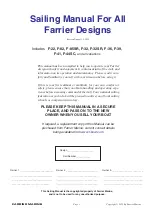
Chapter 4
B
O A T H A N D L I N G G U I D E L I N E S
/ S
A F E T Y R E G U L A T I O N S
• Always observe the rules of the road and use common sense and courtesy on
the water. If you think of it as driving a car, it becomes a bit easier. If a boat
is coming towards you, you should pass that boat keeping it on your port
(left) side.
• In a “crossing situation,” that is, another boat passing in front of you, if the
boat is on your starboard (right) side, that boat has right-of-way.
• In an “overtaking situation,” the boat being overtaken (passed) has the right-
of-way. The overtaking boat should pass on the port side of the boat being
overtaken with a single blast of the horn. If you have to pass a boat on the
starboard side for some safety reason, two blasts from the horn are required.
• When you encounter an unpowered boat like a sailboat or canoe, these boats
ALWAYS have the “right-of-way”. If a sailboat is using a motor, it must
follow the “Rules of the Road.”
• Do not demand the right-of-way, even if you are correct. The only correct
move is to avoid a collision.
• NEVER OPERATE YOUR BOAT UNDER THE INFLUENCE OF
ALCOHOL OR OTHER CONTROLLED SUBSTANCES!! This puts you
and your passengers in danger as well as other boaters on the water.
• While the engine is running, and during the boat mooring, all occupants
should be properly seated. Do not sit on engine box, seat backs, or gunnels,
etc. You COULD fall overboard and be hit by the propeller. Do not allow
objects, arms or legs or any other body parts to hang over the bow or gunnels.
• Look carefully before turning, especially when you are turning around to
pick up a fallen skier. Someone else may not be following the “Rules of the
Road.”
• Keep a visual check for boats behind your boat. This is an area where
accidents can happen very quickly.
• Do not stand while the boat is moving.
• Sit in the driver's seat while the boat is moving and INSIST that your
passengers remain properly seated.
• Do not sit on the gunnels, deck, seat backs, boarding platform or engine box
while the engine is running or while the boat is moving.
• Make sure you have a properly sized Coast Guard Approved PFC (Personal
Flotation Device) on board and easily accessible for each person.
4.1
Ski 10.qxd 9/1/00 2:43 PM Page 4.1
Summary of Contents for Ski Nautique
Page 2: ......
Page 6: ...v Ski 10 qxd 9 1 00 2 41 PM Page v ...
Page 7: ...1 1 ...
Page 8: ......
Page 26: ...1 18 Ski 10 qxd 9 1 00 2 42 PM Page 1 18 ...
Page 27: ...2 2 ...
Page 28: ......
Page 34: ...2 6 Ski 10 qxd 9 1 00 2 42 PM Page 2 6 ...
Page 35: ...3 3 ...
Page 36: ......
Page 40: ...3 4 Ski 10 qxd 9 1 00 2 43 PM Page 3 4 ...
Page 41: ...4 4 ...
Page 42: ......
Page 45: ...5 5 ...
Page 46: ......
Page 58: ......
Page 59: ...6 6 ...
Page 60: ......
Page 63: ...7 7 ...
Page 64: ......
Page 68: ...7 4 Ski 10 qxd 9 1 00 2 43 PM Page 7 4 ...
Page 69: ...8 8 ...
Page 70: ......
Page 99: ...9 9 ...
Page 100: ......
Page 102: ......
Page 104: ......
Page 106: ......
Page 108: ......
Page 112: ......
Page 116: ......
Page 117: ...9 11 Ski 10 qxd 9 1 00 2 43 PM Page 9 11 ...
Page 118: ......
















































